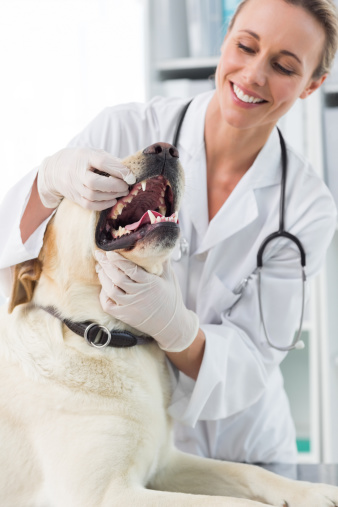Preventing Periodontal Disease
Pet Age Staff //February 23, 2017//
Periodontal disease is one of the most common and overlooked disease in veterinary medicine, according to Forever Freckled’s Dr. Alison Birken. Just like in humans, poor dental health can result in serious health issues, such as heart disease, and an increased risk of cancer, diabetes and pancreatic disease. So why is dental disease an epidemic? What can pet owners do to ensure our pets live longer and happier lives by preventing periodontal disease? The first step is to have pets’ teeth evaluated by your veterinarian. Many of Dr. Birken’s pet parents do not realize their pets have dental disease. Commonly, her clients bring their pets to see her with complaints that their breath smells horrible or eating habits have changed. These are the most common signs of periodontal disease. Recognizing the signs of periodontal disease is the first step in improving pets’ oral care and overall health.
The following are some clinical signs Dr. Birken gives that may suggest a pet has periodontal disease:
- Halitosis (bad breath). Persistent bad breath is generally the first sign people notice.
- Gums that bleed easily. Is there blood on pets’ bones or toys? This is a sign of possible gingivitis and should be evaluated by a veterinarian.
- Changes in eating behaviors. If a pet is eating slower or chews only on one side of their mouth, this can be a sign of pain and possible periodontal disease.
- Loss of appetite. Always have pets evaluated by a veterinarian when they are not eating.
- Pawing at the mouth. This can be a sign of oral pain.
- Sensitivity around the mouth. If a pet no longer allows people to rub their chin or mouth area, this may be a sign of discomfort due to dental disease.
- Loose or missing teeth.
- Yellow or brown hardened material on the tooth. This is usually tartar and needs to be cleaned professionally with a scaler and ultrasonic cleaner by a veterinarian.
- Discoloration of a tooth. This may be a sign of a tooth root abscess or decaying tooth.
- Purulent exudate (pus) around the tooth. This may be a sign of an infection.
- Gums that are inflamed (red), hyperplastic or receding. This may be a sign of gingivitis.
- Swelling under the eye. This may suggest a possible tooth root abscess and needs to be addressed immediately with a veterinarian.
- Constant nasal discharge. This may be a sign of periodontal disease.
- No signs at all. Many pets will not show any clinical signs that they are suffering with periodontal disease. It is imperative to visit a veterinarian for a thorough examination and dental cleaning annually or biannually.
Poor oral health can also be painful and uncomfortable for pets, and sometimes our pets have difficulty expressing that they are in pain, especially if the pain is minor or dull oral pain. So now that we recognized our pets have periodontal disease, what can we do to help improve their dental health? There are many things that can be done at home to not only improve the overall health and wellbeing of pets’ oral hygiene, but also improve their quality of life. The following are some great ways to improve the oral hygiene of our pets, and their overall wellbeing.
Proper Dental Care and Disease Prevention
- At Home Dental Care. This is the single most important measure someone can take to prevent periodontal disease and promote dental health in pets. We need to start brushing our pets’ teeth. Whenever Dr. Birken sees new puppies and kittens, she says she motivate her clients to start teaching pets how to tolerate and even enjoy getting their teeth cleaned. With an adult pet, although more challenging, Dr. Birken encourages people to try and start cleaning their teeth using lots of positive reinforcement. The key is to use a soft bristle toothbrush and pet formulated toothpaste. It is important to make sure the toothpaste is specific and safe for pets, as pets will swallow the toothpaste. Follow-up with a proper rinse that is pet safe to finish the cleaning. We recommend brushing every day, but if you can do it twice weekly, you are way ahead of the game.
- Dental Rinses and Wipes. Use dental rinses or wipes daily.
- Prescription Dental Diet. Dental diets are formulated for reducing the amount of plaque and tartar that accumulate on the teeth and in some cases may even prevent serious oral diseases from occurring. The larger kibble is composed of fibers that actually scrub the teeth’s’ surface to reduce plaque. Ask your veterinarian if a prescription dental diet is appropriate for your pet.
- Dental Chews.
- No Sugars. Avoid treats that are high in sugar as sugar may worsen or cause more dental health problems.
- Veterinarian Dental Check-Ups. Visit a veterinarian for a thorough dental cleaning and examination annually or biannually. Dr. Birken stresses that even if owners are brushing their pets’ teeth regularly, it is still important to get them in at least once a year for a proper teeth cleaning under anesthesia with an ultrasonic scaler and polisher. Just like humans, pets need a thorough cleaning that removes the plaque and tartar under their gum lines that you cannot reach with a toothbrush. The oral examination is imperative to check for disease and ensure dental and overall health.



















